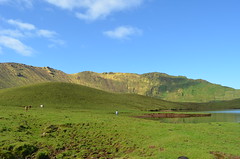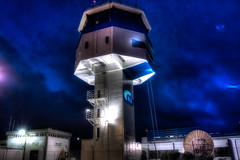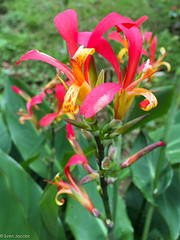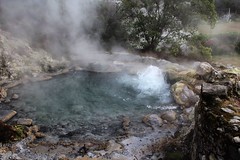Região Autónoma dos Açores
The Azores (English: /əˈzz/ , English: /ˈzz/,; Portuguese: Açores, Portuguese: [ɐˈsoɾɨʃ]) officially the Autonomous Region of the Azores , is one of the two autonomous regions of Portugal (along with Madeira). It is an archipelago composed of nine volcanic islands in the Macaronesia region of the North Atlantic Ocean, about west of Lisbon, about northwest of Morocco, and about southeast of Newfoundland, Canada.
Its main industries are agriculture, dairy farming, livestock, fishing, and tourism, which has become a major service activity in the region. The government of the Azores employs a large percentage of the population directly or indirectly in the service and tertiary sectors. The largest city of the Azores is Ponta Delgada. The culture, dialect, cuisine, and traditions of the Azorean islands vary considerably, because these remote islands were settled sporadically over a span of two centuries.
There are nine major Azorean islands and an islet cluster, in three main groups. These are Flores and Corvo, to the west; Graciosa, Terceira, São Jorge, Pico, and Faial in the centre; and São Miguel, Santa Maria, and the Formigas islets to the east. They extend for more than and lie in a northwest–southeast direction. All of the islands have volcanic origins, although some, such as Santa Maria, have had no recorded activity in the time since the islands were settled several centuries ago. Mount Pico, on the island of Pico, is the highest point in Portugal, at . If measured from their base at the bottom of the ocean to their peaks, which thrust high above the surface of the Atlantic, the Azores are among the tallest mountains on the planet.
The climate of the Azores is very mild for such a northerly location, being influenced by its distance from the continents and by the passing Gulf Stream. Because of the marine influence, temperatures remain mild year-round. Daytime temperatures normally fluctuate between depending on season. Temperatures above or below are unknown in the major population centres. It is also generally wet and cloudy.
History
A small number of alleged hypogea (underground structures carved into rocks) have been identified on the islands of Corvo, Santa Maria, and Terceira by Portuguese archaeologist Nuno Ribeiro, who speculated that they might date back 2,000 years, implying a human presence on the island before the Portuguese. These structures have been used by settlers in the Azores to store grain and the suggestion by Ribeiro that they might be burial sites is unconfirmed. Detailed examination and dating to authenticate the validity of these speculations is lacking; thus it is unclear whether these structures are natural or human-made and whether they predate the 15th century Portuguese colonization of the Azores.
According to a 2015 paper published in Journal of Evolutionary Biology, research based on mouse mitochondrial DNA points to a Scandinavian rather than Portuguese origin of the local mouse population. Some years later, a 2021 paper published in Proceedings of the National Academy of Sciences, using data from lake sediment core sampling suggests brush-clearing was undertaken and animal husbandry introduced between 700 and 850 C.E. Together, these findings suggest a brief period of Norse settlement and the 2021 paper further cites climate simulations carried out that suggest the dominant winds in the North Atlantic Ocean in that period blew from the northeast, which would have taken Viking ships heading southwest from Scandinavia more or less directly to the Azores.
Discovery
The islands were known to Europeans in the 14th century; parts of them appear in the Catalan Atlas, created in 1375. In 1427, a captain sailing for Prince Henry the Navigator, possibly Gonçalo Velho, may have rediscovered the Azores but this is not certain. In Thomas Ashe's 1813 work, A History of the Azores, the author identified a Fleming, Joshua Vander Berg of Bruges, who made landfall in the archipelago during a storm on his way to Lisbon. According to Ashe, the Portuguese explored the area and claimed it for Portugal. Other writers note the discovery of the first islands (São Miguel, Santa Maria and Terceira) by sailors in the service of Henry the Navigator, although there are few documents to support such claims.
Although it is commonly said that the archipelago received its name from (Portuguese for goshawk, a common bird at the time of discovery) it is unlikely that the bird ever nested or hunted on the islands. There were no large animals on Santa Maria; after its discovery and before settlement began, sheep were let loose on the island to supply future settlers with food.
Early settlement
The archipelago was largely settled from mainland Portugal but settlement did not take place right away. Gonçalo Velho Cabral gathered resources and settlers for the next three years (1433–1436) and sailed to establish colonies, first on Santa Maria and then on São Miguel. Settlers built houses, established villages and cleared bush and rocks to plant crops, grain, grapevines, sugar cane and other plants suitable for local use and for export. They brought domesticated animals, such as chickens, rabbits, cattle, sheep, goats and pigs. The settlement of the unoccupied islands started in 1439 with people mainly from the continental provinces of Algarve and Alentejo, in mainland Portugal. São Miguel was first settled in 1449, the settlers – mainly from the Estremadura, Alto Alentejo and Algarve areas of mainland Portugal – under the command of Gonçalo Velho Cabral, who landed at the site of modern-day Povoação.
Flemish settlers
The first reference to the island of São Jorge was made in 1439 but the date of discovery is unknown. In 1443, the island was already inhabited but settlement only began after the arrival of the noble Flemish native Willem van der Haegen. Arriving at Topo, São Jorge, where he lived and died, he became known as Guilherme da Silveira to the islanders. João Vaz Corte-Real received the captaincy of the island in 1483. Velas became a town before the end of the 15th century. By 1490, there were 2,000 Flemings living on the islands of Terceira, Pico, Faial, São Jorge and Flores. Because there was such a large Flemish settlement, the Azores became known as the Flemish Islands or the Isles of Flanders.
Prince Henry the Navigator was responsible for this Flemish settlement. His sister, Isabel, was married to Philip the Good, Duke of Burgundy, Flanders at the time belonging to Burgundy. There was a revolt against Philip's rule, and disease and hunger became rampant. Isabel appealed to Henry to allow some of the unruly Flemings to settle in the Azores. He granted this and supplied them with means of transport and goods.
The 1522 earthquake and recovery
In 1522, Vila Franca do Campo, then the capital of São Miguel, was devastated by an earthquake and landslide that killed about 5,000 people, and the capital was moved to Ponta Delgada. The town of Vila Franca do Campo was rebuilt on the original site, and today is a thriving fishing and yachting port. Ponta Delgada received its city status in 1546. From the first settlement, the pioneers applied themselves to agriculture, and by the 15th century Graciosa was exporting wheat, barley, wine and brandy. The goods were sent to Terceira largely because of the proximity of that island.
Effects of the Portuguese succession crisis of 1580
Portugal fell into a dynastic crisis following the death of Cardinal-King Henry of Portugal in 1580. Of the various claimants to the crown, the most powerful was king Phillip II of Spain, who justified his rights to the Portuguese throne by the fact that his mother was a Portuguese royal princess, his maternal grandfather having been King Manuel I of Portugal. Following his proclamation in Santarém, António, Prior of Crato was acclaimed in the Azores in 1580 (through his envoy António da Costa) but was expelled from the continent by the Spaniards following the Battle of Alcântara. Yet, through the administration of Cipriano de Figueiredo, governor of Terceira (who continued to govern Terceira in the name of ill-fated, former King Sebastian of Portugal), the Azoreans resisted Spanish attempts to conquer the islands (including specifically at the Battle of Salga).
In 1583, Philip II of Spain, as King of Portugal, sent his fleet to clear the Azores of a combined multinational force of adventurers, mercenaries, volunteers, and soldiers who were attempting to establish the Azores as a staging post for a rival pretender to the Portuguese throne. Following the success of his fleet at the Battle of Ponta Delgada captured enemies were hanged from yardarms, as they were considered pirates by Philip II. Opponents receiving the news variously portrayed Philip II as a despot or "Black Legend"; the sort of insult widely made against contemporary monarchs engaged in aggressive empire building and the European wars of religion. Figueiredo and Violante do Canto helped organize a resistance on Terceira that influenced some of the response of the other islands, even as internal politics and support for Philip's faction increased on the other islands (including specifically on São Miguel, where the Gonçalvez da Câmara family supported the Spanish claimant).
English raids of 1589 and 1598
An English raid of the Azores in 1589 successfully plundered some islands and harbouring ships; eight years later, a second raid failed – the Islands Voyage.
Iberian Union
Spain held the Azores under the Iberian Union from 1580–1642 (called the "Babylonian captivity" in the Azores). The Azores were the last part of the Portuguese Empire to resist Philip's reign over Portugal (Macau resisted any official recognition), until the defeat of forces loyal to the Prior of Crato with the Conquest of the Azores in 1583. Portuguese control resumed with the end of the Iberian Union in 1640, and the beginning of the Portuguese Restoration War, not by the p…
Looking for places related to Região Autónoma dos Açores?
Those are other destinations to find places related to Região Autónoma dos Açores:
























